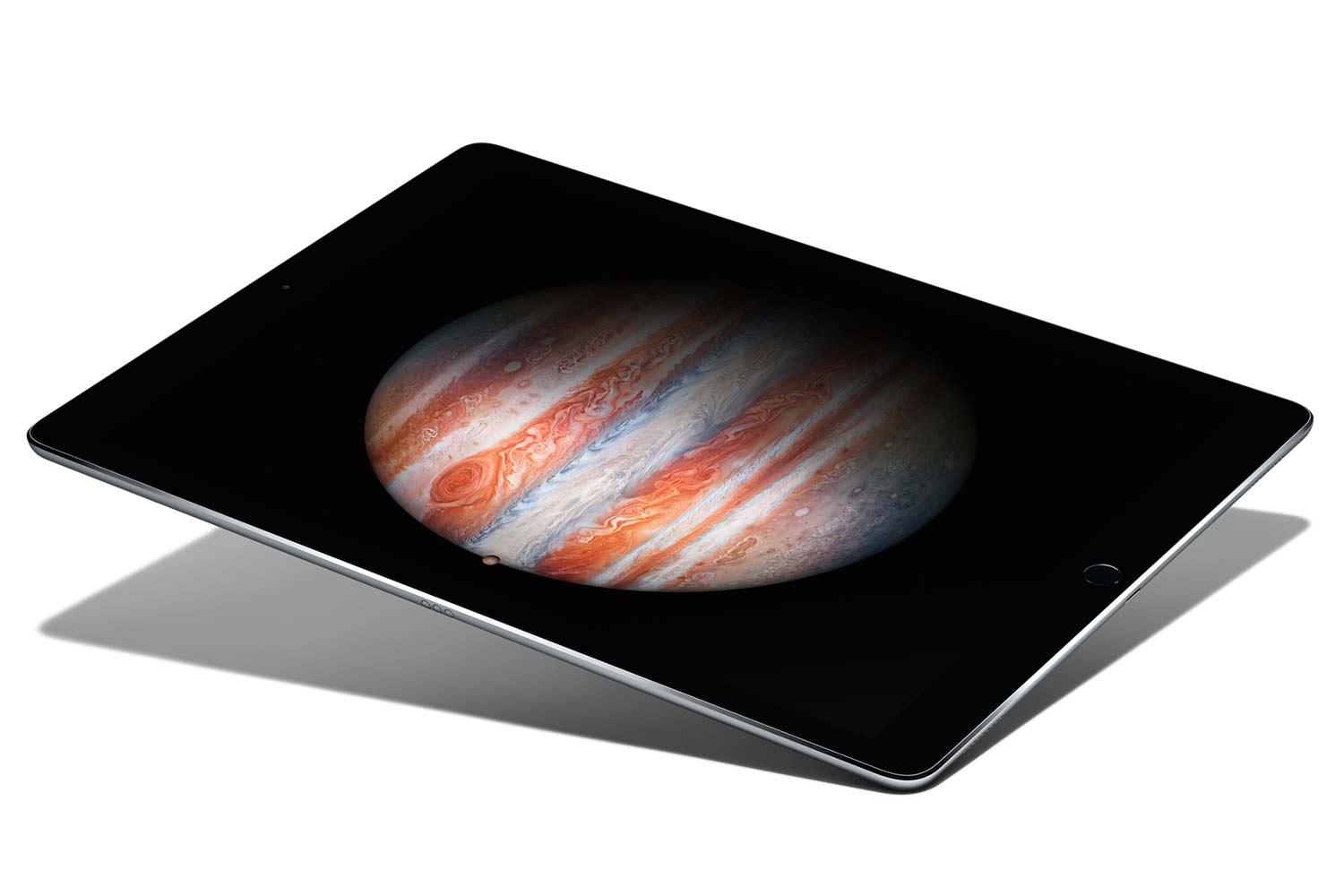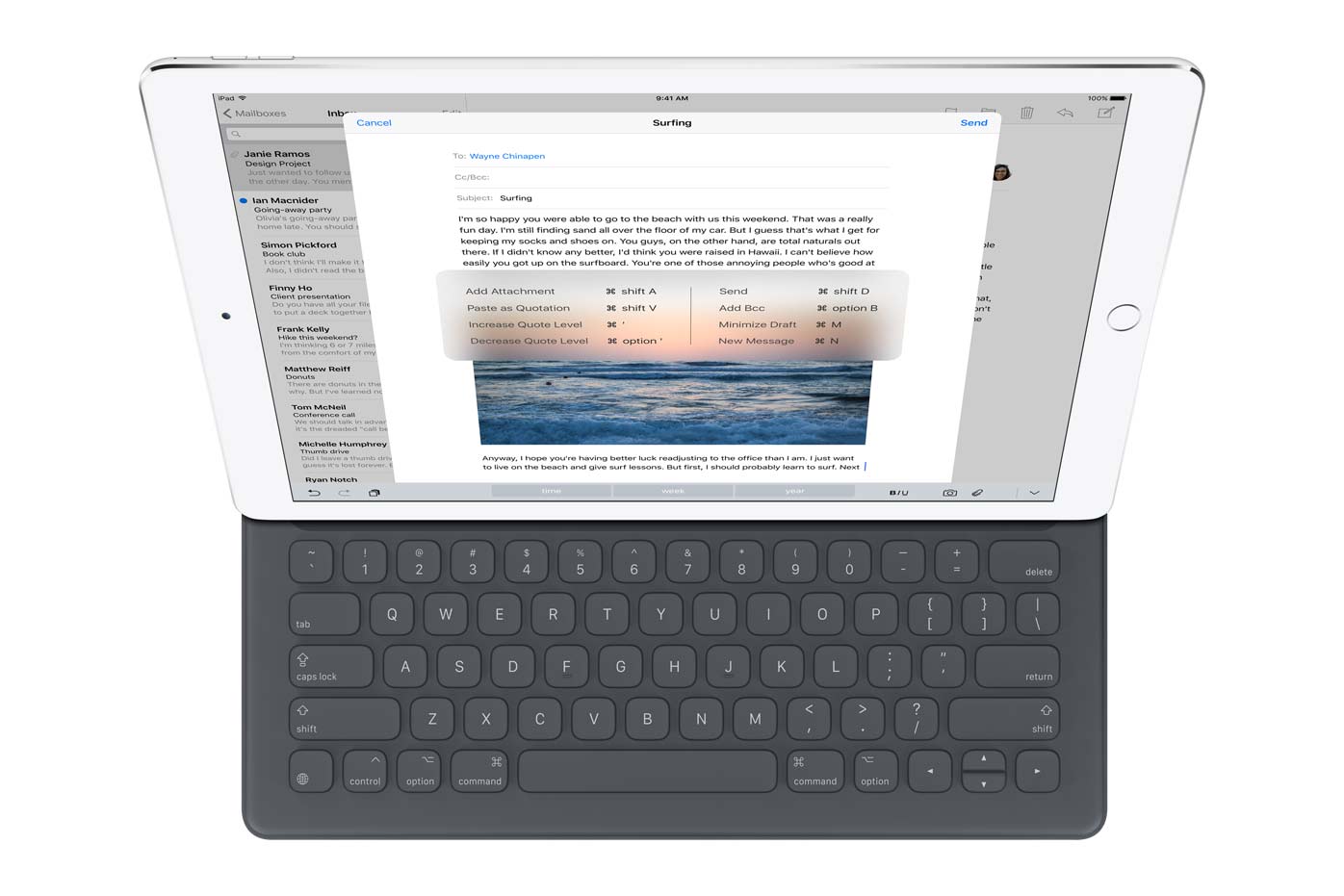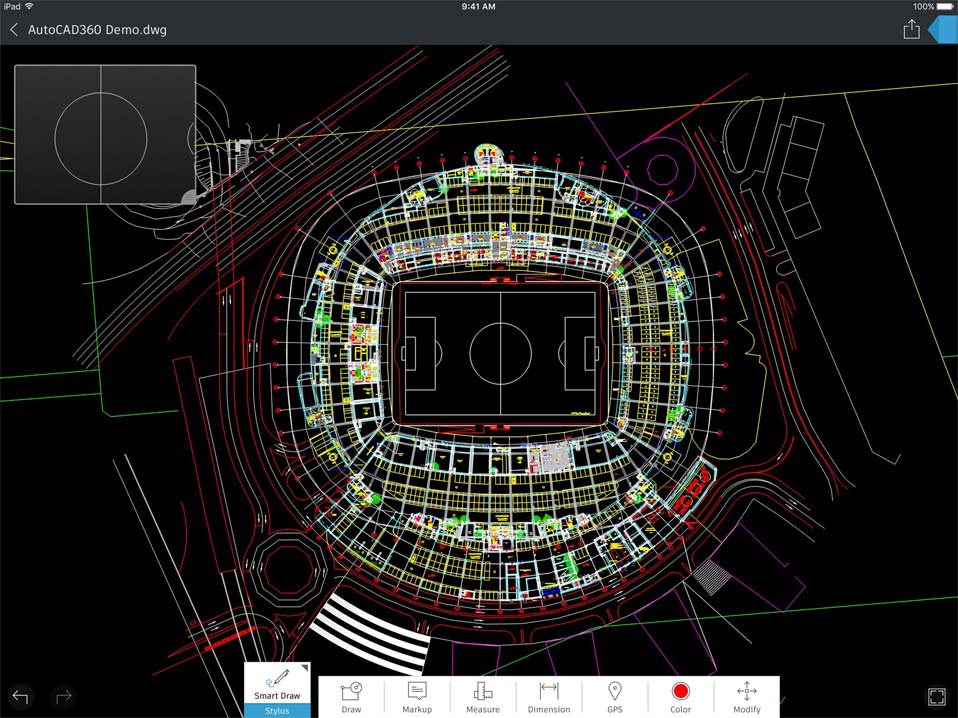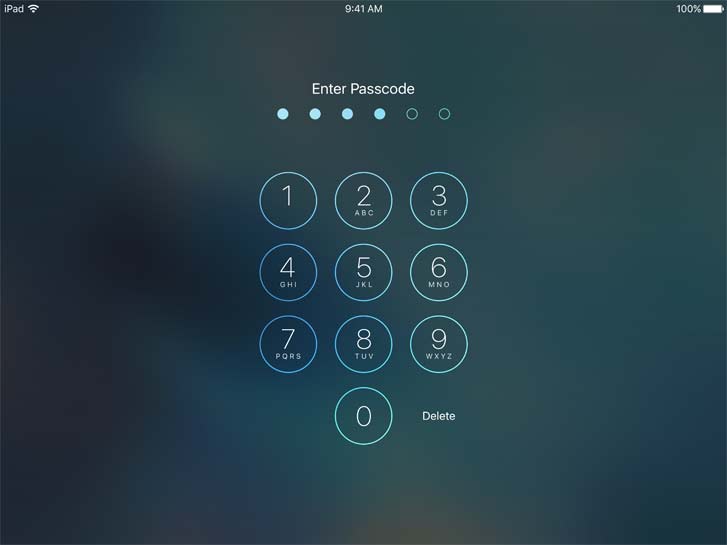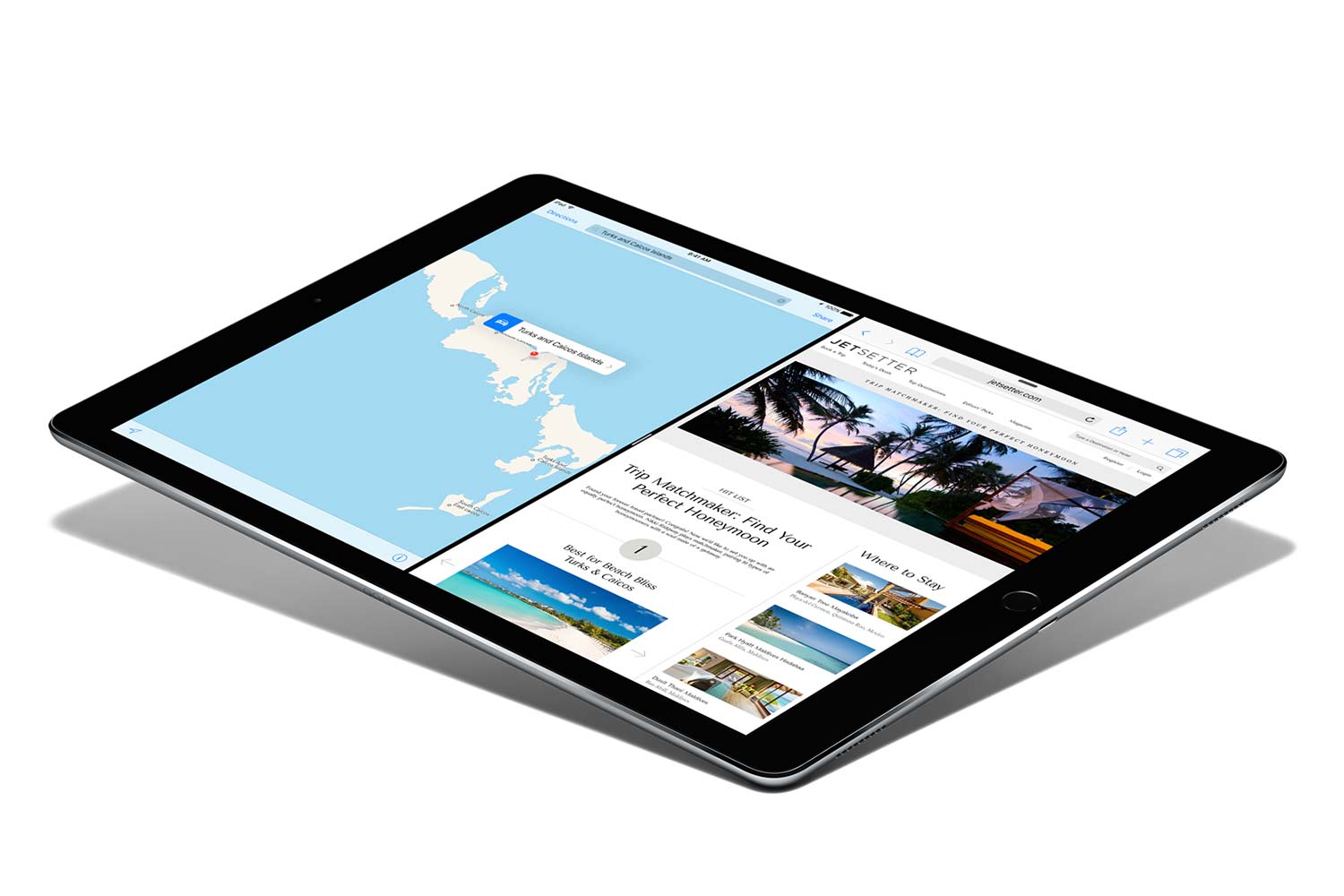
It’s tempting to dismiss the iPad Pro as a comically over-sized iPad, but that would mean making the same mistake as those who dismissed the original iPad as an oversized iPhone. Though it runs iOS, the Pro’s size and performance puts it in contention with 2-in-1 computers like Microsoft’s Surface Pro 3. There’s reason to believe it’ll trump even the recently released MacBook, and become the most influential PC released since the MacBook Air.
Size matters
Two years ago I wrote an article about my experience using an iPad as a replacement for my PC. The experiment went well, and while the iPad itself wasn’t capable of completely replacing a notebook or desktop, it proved itself a reasonable complement. The main issue was size. At 10 inches, the display of the standard iPad (now iPad Air) is smaller than almost any PC, and that means any attached keyboard will be tight, as well.
The iPad Pro fixes that problem. Its 12.9-inch display is nearly the size of a MacBook Pro, larger than a MacBook, and larger than a Surface Pro 3. As Apple highlighted, this means users will be able to easily run two apps side-by-side, if desired, without a loss of functionality. It also gave Apple the chance to craft a full-sized keyboard cover – and as exciting as that is, I’m even more interested to see what third-party manufacturers like Logitech and Zagg come up with.
Of course, the larger screen will make the iPad Pro less competent as a tablet. For some users, even the iPad is too large, which is why the iPad Mini continues to do well. The Pro is even bigger than its size seems to indicate. The 4:3 screen measures about 8.7 inches wide and 12 inches tall (held in portrait mode). It also weighs 1.57 pounds. By comparison, the iPad Air 2 is 6.6 inches by 9.4 inches and weighs a hair under a pound. Overall, the Pro is about 40 percent larger than the Air 2.
That’s the trade-off. It’s a purposeful one, made by Apple for the same reason the Surface Pro 3 ditched the 10.6-inch display on earlier models. Microsoft changed the display’s size because it realized a true compromise wasn’t possible; something had to be prioritized, and the company’s designers decided on productivity. Apple has made the same decision with the iPad Pro.
A computer in tablet’s clothing
In a sense, the iPad Pro’s name is a bit deceiving. Accusations that tablets are useful only for consumption, rather than productivity, have sunk in and been accepted widely as simple fact. That makes it hard to envision anything called an “iPad Pro” as more than a plus-sized version of the Air.
But it’s much more than that. Part of the reason is the hardware. Apple’s chip designers are top-notch, and they’ve worked hard to ensure the A9X can compete with the best in the world. I’m skeptical of Apple’s claim that the iPad Pro beats 80 percent of portable PCs sold in the last year — some very specific metrics are being used to achieve that number, I suspect. The rather vague graphs shown by Tim Cook suggest the Pro’s processor is about 30 percent quicker in compute performance than an iPad Air 2, and nearly twice as quick in graphics performance.
That, combined with the new multi-tasking features in iOS 9, suddenly make the iPad Pro look like a real threat to Windows 2-in-1s. That may sound crazy, but think of it this way — in Windows 10 tablet mode, Windows apps open full screen by default, and viewing more than two apps at once on a 12-inch screen (like the Surface Pro 3) isn’t feasible no matter the operating system. While iOS is not a rival to Windows 10 in conventional desktop multi-tasking, it’s not far behind the capabilities of Windows 10’s tablet interface.
And then there’s the keyboard and stylus. Apple has never offered either for an iPad; the existence of both makes it clear that this new tablet is targeting an entirely different kind of user. While the iPad Mini, iPad Air 2 and iPad Pro are all part of the same family, they’re built for very different users, and the Pro’s feature set aims it straight at those who are considering a Windows 2-in-1.
The software quagmire
The iPad Pro’s hardware makes the device’s intentions clear, but the software – or more specifically, its implications – is a bit more confusing. The Pro runs iOS, but it’s several times larger than the smallest iPhone. It’s priced similarly to Windows and OS X machines, and it repeats many features of OS X.
Fans of the Mac have worried for years that Apple might phase out its support for OS X in favor of iOS devices, or that the company might dumb down OS X by borrowing too many features from its mobile sibling. The iPad Pro, though, suggests the real threat may come from entirely new devices with hardware that infringe on the Mac’s territory, but run only iOS.
It’s not at all clear, at this point, that such a tactic will work. The new iPad isn’t even out yet. But Apple’s decision to invite the Microsoft Office team on stage makes it very clear that, in terms of software functionality, Apple itself considers the Pro to be a potential rival for the Mac. In fact, iPad Pro was presented in a way that has a lot more in common with a Mac than an iPad. Productivity apps took the lion’s share of attention, rather than games, device size, or battery life.
To some, this will be confusing, but if Apple can pull this off – if the iPad Pro 2 is a solid productivity machine – it’ll be the first time any company has managed a 2-in-1 that was competent as both tablet and computer. That’s a big deal, and as with all successful Apple products, it would surely pave the way for imitators.
Move over, MacBook
Just a few months ago, in my review of the MacBook, I called it “the most forward-thinking device Apple currently sells.” It appears that the latest Mac may have already lost that title. The iPad Pro has the potential to be innovative. Should it succeed, it’ll change how computers, tablets, and operating systems are designed.
The caveat is the “should.” The MacBook has already made its mark. Whatever its flaws, that super-thin notebook is the blueprint that all other ultraportable laptops will follow over the next five years. The iPad Pro’s legacy is not so firmly planted, not only because the device isn’t out, but also because it’s more daring. The MacBook made some controversial but inevitable changes to notebook design. The iPad Pro tries to throw both tablets and notebooks out the window.
A lot of companies have already tried this, most notably Microsoft, but the company’s efforts haven’t taken hold. IFA 2015, though it had much to excite PC users, was proof that computer makers were out of ideas for the 2-in-1. Tired 360-hinge and dockable designs were rehashed, yet again.
Apple is a successful company not because it crafts previously unheard ideas, but because it perfects ideas that seem too wonky to be useful. The 2-in-1 computer badly needs such treatment. If it’s as good in practice as it looks on paper, the iPad Pro will breath new life into this young, struggling category, and change computers forever in the process.

